|
Page < 1 2 3 4 5 6 7 8 9 10 11 12 13 14 15 16 17 18 19 20 21 22 23 24 25 >
Show
in alphabetical order
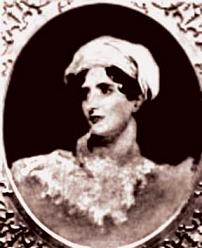 421
Lady Callcott (Mrs
Graham)
(1785 - 1842) One
of the spectacular exceptions to the English Memsahibs was a
woman called Maria Graham who came to India with her father
Rear-Admiral George Dundas of the Royal Navy. She married Capt
Thomas Graham of the Royal Navy. Later she became Lady Callcott
by her second marriage. Her 'Journal
of a Residence in India', dealing with her
experiences mainly in the coastal areas of India during the
period from 1809 to 1811 was first published in England in 1812. 421
Lady Callcott (Mrs
Graham)
(1785 - 1842) One
of the spectacular exceptions to the English Memsahibs was a
woman called Maria Graham who came to India with her father
Rear-Admiral George Dundas of the Royal Navy. She married Capt
Thomas Graham of the Royal Navy. Later she became Lady Callcott
by her second marriage. Her 'Journal
of a Residence in India', dealing with her
experiences mainly in the coastal areas of India during the
period from 1809 to 1811 was first published in England in 1812.
She
was culturally very different from most of the English Ladies
who came to India along with their husbands.
She
was a great lover of India and clearly stated in her Journal
that one of her purposes was 'to exhibit a sketch of India's
former grandeur and refinement so that I could restore India to
that place in the scale of ancient nations, which European
historians have in general unaccountably neglected to assign to
it'.
She wrote eloquently about the
grandeur of Sanskrit language and literature, its majesty of
thought and loftiness of expression.
She
went to Mahabalipuram along
with a Brahmin servant of Col Colin Mackenzie and stayed there
for three days. The Oriental Manuscripts Library in Madras today
contains all the manuscripts collected by Col Mackenzie between
1792 and 1815. Lady Calcott gave a beautiful description of
Mahabalipuram and its environs in her Journal.

Lady Callcott (Mrs
Graham).
She wrote
eloquently about the grandeur of Sanskrit language and
literature, its majesty of thought and loftiness of expression. Which
was written eight years before the birth of Max Mueller and
almost half a century before he published the first volume of
his famous series 'Sacred Books of the East'.
***
About
the glory and greatness of Sanskrit
language she wrote with great passion as follows:
'Were
all other monuments swept away from the face of Hindustan, were
all its inhabitants destroyed, and its name forgotten, the
existence of the Sanskrit language would prove that it once
contained a race who had reached a high degree of refinement,
and who must have been blessed with many rare advantages before
such a language could have been formed and polished. Amidst the
wreck of nations where it flourished, and superior to the havoc
of war and conquest, it remains a venerable monument of the
splendour of other times, as the solid Pyramid in the deserts of
Egypt'.
This
was written eight years before the birth of Max Mueller and
almost half a century before he published the first volume of
his famous series 'Sacred Books of the East'.
(source: Lady
Callcott in Madras, a great lover of Sanskrit
- By V Sundaram - newstodaynet.com). For more refer
to chapters on European
Imperialism and First
Indologists and Sanskrit.
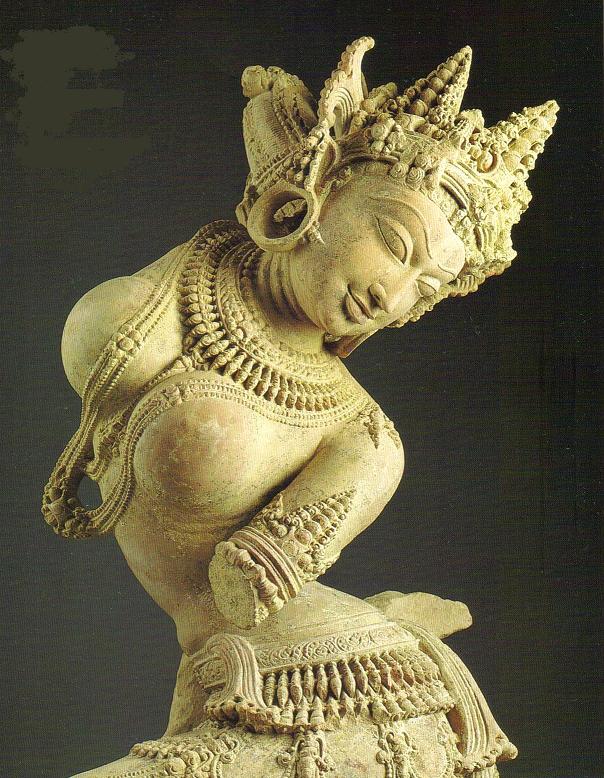
Dancing
Devata, stone, early 12th century, Uttar Pradesh, India.
"
Indian art as "a
monument of a philosophical system in the history of mankind and
doubted whether any
other people on earth have treated symbolism in art as
thoroughly as Indians" - wrote
J G Von Herder
(image
source: Metropolitan Museum of Art).
***
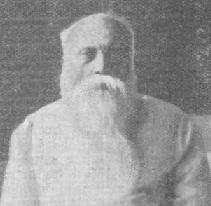 422. Sir
Brajendranath Seal (1864-1938) Knight Vice
Chancellor Mysore University. Seal's major published work is The
Positive Sciences of the Ancient Hindus, which, besides being a
work on the history of science, shows interrelations among the
ancient Hindu philosophical concepts and their scientific
theories. Sir
Brajendranath Seal, had coined a very appropriate term to
describe
India
as 'ever ageing but never old'. That is also the meaning of
Sanskrit word purana which usually means ancient and old.
Shankaracharya in his commentary of Gita describes Atman, the
infinite self of man as Purana. 422. Sir
Brajendranath Seal (1864-1938) Knight Vice
Chancellor Mysore University. Seal's major published work is The
Positive Sciences of the Ancient Hindus, which, besides being a
work on the history of science, shows interrelations among the
ancient Hindu philosophical concepts and their scientific
theories. Sir
Brajendranath Seal, had coined a very appropriate term to
describe
India
as 'ever ageing but never old'. That is also the meaning of
Sanskrit word purana which usually means ancient and old.
Shankaracharya in his commentary of Gita describes Atman, the
infinite self of man as Purana.
"The Hindus no less than the
Greeks have shared in the work of constructing scientific
concepts and methods in the investigating of physical phenomena,
as well as of building up a body of positive knowledge which has
been applied to industrial technique; and Hindus scientific
ideas and methodology (eg. the inductive method or methods of
algebraic analysis) have deeply influenced the course of natural
philosophy in Asia - in the East as well as the West - in China
and Japan, as well as in the Saracen Empire. "
Seal explains in his book, The Positive Sciences of
the Ancient Hindus:
"that the
Sankya-Patanjali
system of cosmology expresses the fundamental
idea of conservation, transformation, and dissipation of energy.
Every phenomena in the universe is based on the interaction of
intelligence, energy and mass. This is modern physics in a
nutshell - a world view that was born out of the ashes of the
materialistic and mechanistic views of classical physics of the
Eighteenth and Nineteenth Centuries."
(source: The Positive Sciences of
the Ancient Hindus - By Sir
Brajendranath Seal).
423
Professor Edward Washburn Hopkins (1857-1932)
graduated at Columbia
University
in 1878, studied at
Leipzig, where he
received the degree of Ph.D. in 1881 and became professor of
Sanskrit and comparative philology
in Yale
University
in 1895. He
became secretary of the American Oriental Society and editor of
its Journal, to which he contributed many valuable papers,
especially on numerical and temporal categories in early
Sanskrit literature.
He
observed:
"Plato is full of Sankhyan
thought, worked out by him, but taken from Pythagoras. Before
the sixth century B.C. all the religious-philosophical idea of
Pythagoras are current in India (L. Schroeder, Pythagoras). If
there were but one or two of these cases, they might be set
aside as accidental coincidences, but such coincidences are too
numerous to be the result of change. "
And
again he writes: "Neo-Platonism
and Christian Gnosticism owe much to India. The Gnostic ideas in
regard to a plurality of heavens and spiritual worlds go back
directly to Hindu sources. Soul
and light are one in the Sankhyan system, before they became so
in Greece, and when they appear united in Greece it is by means
of the thought which is borrowed from India. The famous three
qualities of the Sankhyan reappear as the Gnostic 'three
classes."
(source:
Religions
of India - By Edward Washburn Hopkins
p. 559-560).
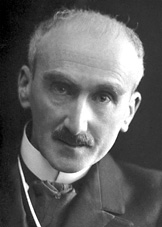 424.
Henri Bergson (1859 - 1941)
French Philosopher and the son of a Jewish musician and an
English woman, was educated at the Lycée Condorcet and the École
Normale Supérieure, where he studied philosophy. After a
teaching career as a schoolmaster,
Bergson was appointed to the École Normale Supérieure in 1898
and held the chair of philosophy at the Collège
de France. He was elected to the Académie Française; then was president of the Commission for
Intellectual Cooperation of the League of Nations. 424.
Henri Bergson (1859 - 1941)
French Philosopher and the son of a Jewish musician and an
English woman, was educated at the Lycée Condorcet and the École
Normale Supérieure, where he studied philosophy. After a
teaching career as a schoolmaster,
Bergson was appointed to the École Normale Supérieure in 1898
and held the chair of philosophy at the Collège
de France. He was elected to the Académie Française; then was president of the Commission for
Intellectual Cooperation of the League of Nations.
He
observed that:
"From
the earliest times divine and many of the great pilgrimages of
Hindu India were focused upon sacred rivers such as the Ganges,
Indus, Yamuna, Krishna, Godavari, and
Brahmaputra.
The largest religious festival in the world today, held every
12 years near
Allahabad,
India
and attracting upwards of twenty million pilgrims, takes place
at the confluence of two rivers."
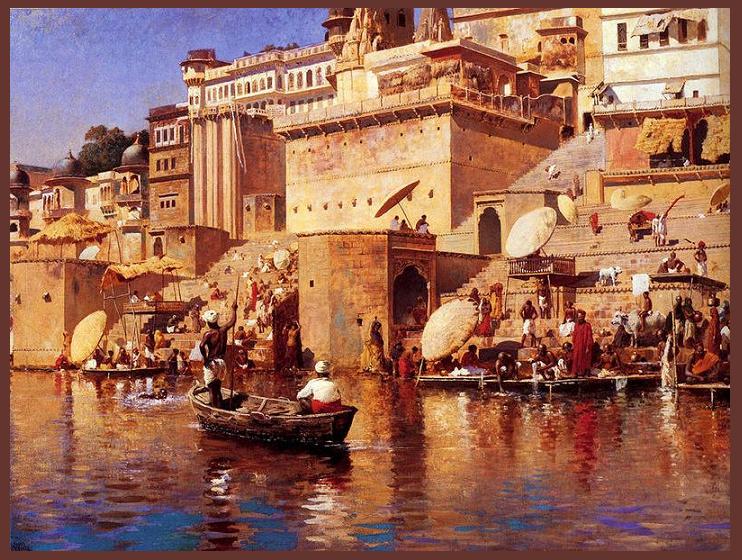
Ghats
on River Ganga.
"From
the earliest times divine and many of the great pilgrimages of
Hindu India were focused upon sacred rivers such as the Ganges,
Indus, Yamuna, Krishna, Godavari, and
Brahmaputra.
(image
source: Paintings by Edwin Lord Weeks 1849 - 1903).
***
The power of that blended water is said to grant a spiritual
realization that does not die with the passing of the human
form. Holy mountains were also known to be sources of sacred
waters. Upon their lofty summits resided storm gods and weather
deities, whose gifts of rain sustained all plant, animal and
human life. Particular frozen waters were also favored and
pilgrims still trek long distances in the high mountains to
reach Amarnath cave in Kashmir and
Lake
Manosarovar
(the
lake was first created in the mind of the Lord
Brahma. Hence, in Sanskrit it is called "Manas
sarovara", which is a combination of the words manas (mind)
and sarovara (lake) in Tibet.
Sprawling
miles along the holy river Ganges, the city of
Banaras
(also called
Varanasi
or Kashi) is the most visited pilgrimage destination in all of India.
Myths and hymns speak of the waters of the
Ganges
as the fluid medium of Shiva's divine essence and a bath in the
river is believed to wash away all of one's sins. The Hindu
scripture Tristhalisetu
explains that,
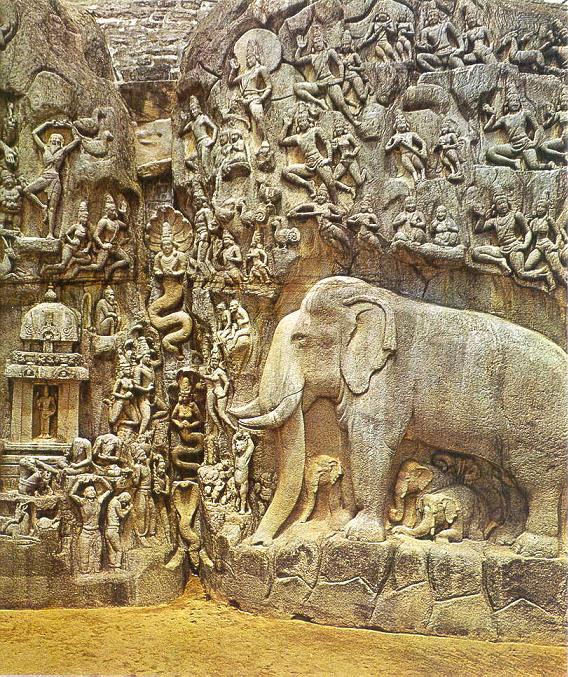
The
descent of the River Ganga.
Sacred
stories and hymns speak of the waters of the
Ganges
as the fluid medium of Lord Shiva's divine essence and a bath in the
river is believed to wash away all of one's sins.
***
"There whatever is sacrificed, chanted, given in charity,
or suffered in penance, even in the smallest amount, yields
endless fruit because of the power of that place. Whatever fruit
is said to accrue from many thousands of lifetimes of
asceticism, even more than that is obtainable from but three
nights of fasting in this place."
One of seven Holy Cities of India, one of twelve
Jyotir Linga
Shiva sites and a Shakti Pitha goddess site as well, riverside
Banaras is also the most favored place for Hindus to die.
Cremation at the holy city insures moksha, or final liberation
of the soul from the endless cycle of birth, death and rebirth.
Dying persons and dead bodies from far-off places are brought to
Banaras for cremation at the five principal and eighty-eight
minor holy sites along the river
Ganges
. But the water borne holiness of the ancient city is not
limited to the river alone. Adjacent to Visvwanatha
temple, the
city's primary Shiva Linga, flows the Jnana Vapi
well, the
ritual center and axis mundi of
Banaras
. The Jnana Vapi, or Well of Wisdom, is said to have been dug by
Shiva himself, and its waters carry the liquid form of jhana,
the light of wisdom. Encircling the holy city at a radius of
five miles is the sacred way known as the Panchakroshi Parikrama.
Pilgrims take five days to circumambulate Kashi on this
fifty-mile path, visiting 108 geomantically situated shrines
along the way. If one is unable to walk the entire grid of the
sacred geography, then a visit to the Panchakroshi
Temple
will suffice. By walking round the sanctuary of this shrine,
with its 108 wall reliefs of the temples along the sacred way,
the pilgrim makes a symbolic journey around the sacred city.
Another important
Banaras
pilgrimage route is the Nagara Pradakshina, which takes two days
to complete and has seventy-two shrines.
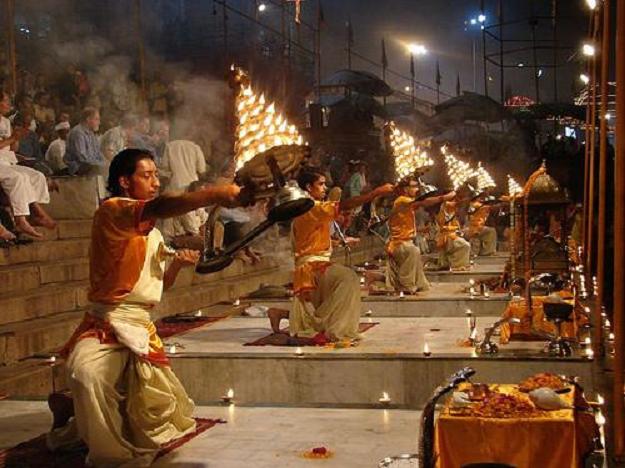
At
evening, priests perform aarti (worship with lighted lamps) at
some of the more famous
ghats & the scene is just beyond descriptions. Thousands of
people attend this aarti ceremony, including hundreds of
foreigners.
Varanasi
or
Banaras
in the state of Uttar Pradesh in Indiais the oldest living city
in the world. Established in 7th century B.C., Varanasi
is the holiest of the holy cities to Hindus.
(image
source: asis
k. chatt's photostream).
***
The sacred architecture
of the temples on both these sacred geographies was designed
with the mathematical and magical formulas of Vastu Purusa, an
Indic geomantic system similar to but older than Chinese Feng
Shui.
Hindus call the sacred places to which they travel tirthas, and
the action of going on a pilgrimage tirtha-yatra. The Vedic word
tirtha means river ford, steps to a river, or place of
pilgrimage. Tirthas are more than physical locations, however.
Devout Hindus believe them to be spiritual fords, the meeting
place of heaven and earth, the locations where one crosses over
the river of samsara (life and death in the illusion of the
material world) to reach the distant shore of liberation. As
thresholds between heaven and earth, tirthas are bridges for
psychic sojourns and the passage of prayers, they are portals
into our physical realm for spirits and deities, angels and
elementals.
"Karma
has quite a karma. Long after India's seers immortalized it in
the Vedas, it suffered bad press under European missionaries who
belittled it as "fate" and "fatalism," and
today finds itself again in the ascendancy as the subtle and
all-encompassing principle which governs man's experiential
universe in a way likened to gravity's governance over the
physical plane. Like gravity, karma was always there in its
fullest potency, even when people did not comprehend it."
(source: experiencefestival.com).
425.
Savitri
Devi (1905 - 1982) was
born Maximiani Portas, of English and Greek parents in Lyons, France. After becoming a Greek national she took to Hellenism,
and was disillusioned with Christianity.
It was the swastikasigns on the palace
of
Athens, built by 19th century German archaeologist Heinrich
Schliemann, that stirred Maximiani's first feelings
for the Aryan race. She left for India
to search for the roots of the Aryan civilisation. She regarded
Hinduism as the only living Aryan heritage in the modern world
and was convinced that only Hinduism could take on and oppose
the Judaeo-Christian heritage. Soon, she adopted the name
Savitri Devi which would make her famous in neo-Nazi circles.
India
fascinated
her - she noted now even a street-side vendor would discuss the Mahabharat
in the morning. In 1939, she published A
Warning to Hindus under the auspices of the
Hindu Mission. In the book, she scorned the Congress for its
secular policies and said there was no India
but a Hindu one and warned the Hindus not to let the Muslims
overwhelm them. In
1939 Savitri Devi met and married a Bengali Brahmin, Asit
Krishna Mukherjee, in a Hindu ceremony in Calcutta. During
the war the couple gathered intelligence on behalf of the Axis,
and Mukherji put Subhas Chandra Bose
in contact with the Japanese, who would later support his Indian
National Army in its abortive campaign against the British.
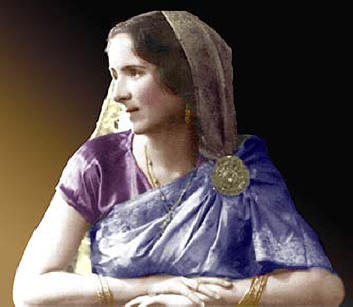
Saviitri
Devi
born Maximiani Portas, was disillusioned with
Christianity and she took to Hellenism. India fascinated her
deeply. She regarded
Hinduism as the only living Aryan heritage in the modern world
and was convinced that only Hinduism could take on and oppose
the Judaeo-Christian heritage.
"We
defend Hinduism, because it is India’s very self-expression;
and we love India, because it is India." Hinduism is really
superior to other religions, not for its spirituality, but for
that still more precious thing it gives to its followers: a
scientific outlook on religion and on life." "Even
if India itself were to disappear just now, the philosophical
and spiritual inheritance of the Hindus would remain. Mankind
would preserve Hinduism, because it is worth preserving. It is
immortal, and needs no one to defend it."
***
“If
those of Indo-European race regard the conquest of pagan Europe
by Christianity as a decadence, then the whole of Hindu India
can be likened to a last fortress of very ancient ideals, of
very old and beautiful religious and metaphysical conceptions,
which have already passed away in Europe. Hinduism is thus the
last flourishing and fecund branch on an immense tree which has
been cut down and mutilated for two thousand years."
"Hinduism
is the most perfect type of such "religions" Apart
from the high philosophies contained in the Hindu Scriptures and
from the high spiritual ideal realized by the Hindu seers, we
want to defend Hindu civilization and society, against the
increasing forces of rival proselytizing societies strongly
united by the consciousness of a common creed. Even if India
itself were to disappear just now, the philosophical and
spiritual inheritance of the Hindus would remain. Mankind would
preserve it, because it is worth preserving. It is immortal, and
needs no one to defend it."
"We defend Hinduism,
because it is India’s very self-expression; and we love India,
because it is India." Hinduism is really superior to other
religions, not for its spirituality, but for that still more
precious thing it gives to its followers: a scientific outlook
on religion and on life. Hindu spirituality is a consequence of
that very outlook. That scientific character of Hinduism should
be looked upon by the Hindus as their strength, not as a
weakness, like some seem to believe. The man of one book and of
one creed may be strong, for the time being; but in the long
run, it is a strength (and the greatest of all strength) for a
religion, to have no particular founder, no particular book, no
particular creed, settled once forever; to be just a continuous
flow of thought, in search of knowledge, on the basis of a
continuously renewed experience." " free thought in all
matters, including religion, is a feature of Hinduism."
Philosophically, Hinduism is an attitude of mind, and an outlook
on life. The Hindus are one of the few modern civilised
people who are openly Pagans."
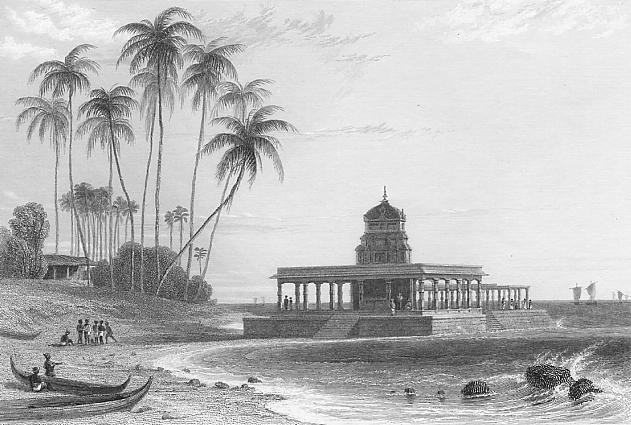
The Hindus are one of the few modern civilised
people who are openly Pagans.
***
"Creation
is only half the Play of Existence. Men thus generally worship
only one side of God. But the Hindus praise Him all round, for
the beauty of His Play. They praise Him in Destruction, as well
as in Creation. They praise His Energy (Shakti) in Mother Kali,
in Durga, in Jagaddatri, in Chinnamasta, continuously destroying
and recreating Her own Self; in all the ten “Mahavidyas,”
who are one and the same. They praise Him in the Dancing King
(Shiva Nataraj), whose feet are over-treading life, and
destroying it in a furious rhythm, . . . while His dispassionate
face, expressing Knowledge, is as calm as the
smiling sea. Creation and destruction are one, to the eyes who
can see beauty.
"And
the greatest praise to India is this: not only are her people
beautiful; not only are her daily life and cult beautiful; but,
in the midst of the utilitarian, humanitarian, dogmatic world of
the present day, she keeps on proclaiming the outstanding value
of Beauty for the sake of Beauty, through her very conception of
Godhead, of religion and of life."
(source: L'Etang
aux lotus (The Lotus pond) - By Savitri Devi, and
A
Warning to the Hindus - By Savitri Devi). Refer
to The
strange case of Savitri Devi - By Koenraad Elst.
426. Sir
George Edward Gordon Catlin (1896 -1979) was an English political scientist and philosopher. A
strong proponent of Anglo-America cooperation, he worked for
many years as a professor at
Cornell
University
and other universities and colleges in the
United States
and Canada. He was an early advocate of Indian independence
after meeting Mahatma Gandhi in 1931 in
London. He visited India
in 1946 and 1947 and published his tribute to Gandhi after his
assassination with In the Path of
Mahatma Gandhi (1948).
In
his book “In the path of Mahatma Gandhi” he asks:
“What
has Islam to offer to compare with the philosophy of Vedanta and
the Upanishads?”
(source: In the Path of
Mahatma Gandhi - By George Edward Gordon Catlin).
"Broad-based
and lofty, Hinduism was and impressive structure? Mohammedanism, with its simple
theology and simple dualism, offered no comparison?"
427.
Vera
Christine Chute Collum (1883
- 1957) scholar and author of The Dance of Civa or Life's Unity
and Rhythm has observed:
"The
conviction that seeming diversities and differences are but
passing and rhythmically varying phases of a fundamental unity
led the East to symbolize Life and Death as the ever supple and
continuously flowing Dance of
Civa, in which construction and destruction
are rhythmically pulsating patterns that the subtle dancer
eternally presents and dissolves with the swiftness of a rapidly
turning wheel."
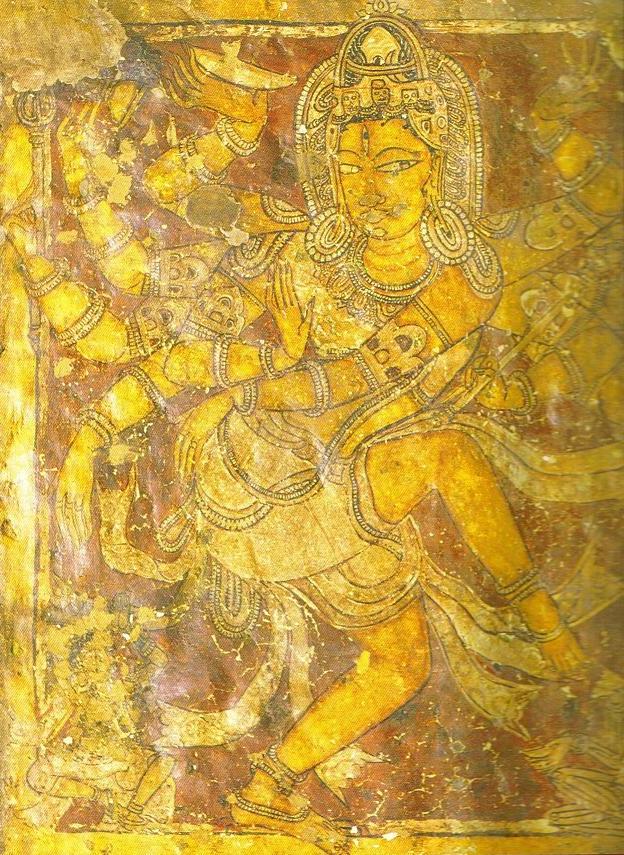
The
Dance of Civa (Shiva).
The work done by physicists since Rontgen’s
accidental discovery has revealed to us Indian conception of the
Dance of Civa – which is continuous, and which is both
constructive and destructive at one and the same time."
***
"Modern science, likewise, is conquering fresh
fields of knowledge since it became aware that many traditional
barriers are illusory. Civilization itself is a ceaseless rhythm
in which Western and Oriental characteristics are vividly
remembered patterns rather than actual attitudes arrested in
their motion."
The Book suggests that recognition of the
ceaseless and musical flow of the Dance of Civa is the antidote
to vain regrets for a pattern that has dissolved only because it
never was fixed, and that reverent acknowledgement of this
underlying synthetic unity is the most promising cure for the
jealousies and misunderstandings that have arisen from a Western
habit of assuming that phantom barriers and conventional
categories have tangible existence.
"Western
science has grown up so entirely in the tradition of Western
thought that very few have questioned whether the current
distinctions between living and non-living, organic and
inorganic are based on real differences in kind or merely on the
idiosyncrasies of Western modes of thinking. Construction and
destruction have been accepted as mutually antagonistic
realities. But the work done by physicists since Rontgen’s
accidental discovery has revealed to us Indian conception of the
Dance of Civa – which is continuous, and which is both
constructive and destructive at one and the same time."
"If
we think how truly an Indian dance is a question of
“patterns” – changing patterns that unceasingly melt into
one another – the symbolism of the Dance of Civa appears to be
poetic in that highest sense in which poetry is a perception of
the specific significance and beauty that informs an idea or
thing and renders it alive and valid. The Western no less than
the Eastern man has always known that the procession of the
seasons, and the cycle of seed-time and harvest have been
characterized by their continuous rhythm, their “life”
dissolving into a sleep of “death” in which a mysterious and
unseen activity has gone on which in due time once more emerges,
as “life” from death. The beauty of the rhythm – the
“Dance” – has again and again kindled poetry in the mind
of the men who have reflected on it.
"
(source: The Dance of Civa or Life's Unity
and Rhythm - By Collum
p. 1 - 63).
 428.
Professor Ernest
E Wood (1883 -
1965) a Sanskrit and Asian scholar, introduced the
Montessori philosophy to the study group who were considering
establishing a new nursery school. Professor Wood lived in India
for 38 years. He founded two University Colleges, acted as
President, Principal and Professor of Physics, English and
Sanskrit at different times. His love for India and its people,
and his deep experience, found expression in active aid to an
educational renaissance initiated by the leaders of India,
including the poet Rabindranath Tagore. He wrote several books
including Practical Yoga and
The Glorious Presence. 428.
Professor Ernest
E Wood (1883 -
1965) a Sanskrit and Asian scholar, introduced the
Montessori philosophy to the study group who were considering
establishing a new nursery school. Professor Wood lived in India
for 38 years. He founded two University Colleges, acted as
President, Principal and Professor of Physics, English and
Sanskrit at different times. His love for India and its people,
and his deep experience, found expression in active aid to an
educational renaissance initiated by the leaders of India,
including the poet Rabindranath Tagore. He wrote several books
including Practical Yoga and
The Glorious Presence.
Vedanta
is considered in India to be the loftiest achievement in
thinking of God. Schopenhauer,
Emerson, William James and Whitehead are deemed by the Wood to
be most in accord with Vedantist teachings.
"The
Vedanta philosophy has as its basis the belief that the universe
of our experience is only one reality and it can be
known."
"If
truth is truth, how can it be unknowable? Wake up, O man, and
look straight, without prejudice, at the facts of being!"
Shankara did not leave the Vedanta teaching as a matter of
religious belief, however, but said we must verify it by
thinking, and the realize it by experience, as did the illumined
men of old. This may be a startling claim, until we
remember how busy we are in these modern days, how
preoccupied with "a number of things," how little we
want "to konw" and how much "to have."
"The
ancient Aryan thinkers who collected, collated, classified and
commented upon the thought-traditions accumulated by their
distant progenitors performed a rational and ethical service of
the greatest value to posterity, when they put together a set of
brief sayings, which they called the Vedanata (the end or
highest point, of knowledge; the "last word"), and
presented them for study along with further statement: "you
will not be able to understand or realize the full import of
these Great Sayings unless you first put your mind in order by
certain practices or disciplines, which we will describe."

Puri ratha
yatra.
(image
source: Indika:
The Country and the people of India and Ceylon - By
Rev. John F Hurst).
***
"The
Yoga School does not bring God in as Ruler of the World, but as
a picture of the ideal soul, for purposes of meditation - a soul
self-governed, and unaffected by the sources of the trouble. To
this Shankar would raise no objection, for with him there is no
objection to idols and images, which have the function of dolls,
as assisting the mind to concentrate in its earlier stages. Even
the Vedantist can meditate on God, provided he remembers that
there is no such external being, and so such being at all unless
that is also his own self."
(source: The
Glorious Presence: A
study of the Vedanta Philosophy and its relation to Modern
Thought - By Ernest E Wood p. 1 - 243).
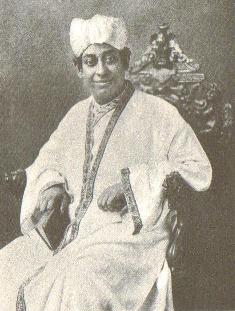 429.
S N (Surendranath) Dasgupta (1887 -
1952) Sanskrit scholar and philosopher. He was the author of several notable books on Indian
philosophy and literature, including the famous one-volume a History
of Indian Philosophy and Yoga
Philosophy. 429.
S N (Surendranath) Dasgupta (1887 -
1952) Sanskrit scholar and philosopher. He was the author of several notable books on Indian
philosophy and literature, including the famous one-volume a History
of Indian Philosophy and Yoga
Philosophy.
Speaking
about Hindu scriptures he wrote:
"The
Vedas were regarded as revelations of eternal truths, truths
which no human reason could ever challenge, naturally divested
reason of confidence in its ability to unravel the mysteries of
man and of the world. The Vedas, then are the only repository of
the highest truths, and the function of reason is only to
attempt to reconcile these truths with our experience and
sense-observation. Reason was never trusted as the only true and
safe guide. This Vedic mysticism prepared the way for the rise
of the other forms of mysticism that sprang up in India."
"The
Upanishads represents one of the most distinctive, types of
mysticism that India has produced. The word
"Upanishad" has been interpreted etymologically by Shankara
to mean "that which destroys all ignorance and leads us to
Brahman." It has also been interpreted to mean a secret or
mystical doctrine, or a secret and confidential sitting. The
Upanishads are mystical experiences of the soul gushing forth
from within us; they sparkle with the beams of a new light; they
quench our thirst, born at their very sight. It was of these
that the German philosopher Schopenhauer
said: "How does every line display its firm and definite
and throughout harmonious meaning.
"From
every sentence deep, original, and sublime thoughts arise and
the whole is pervaded by a high and holy and earnest
spirit."
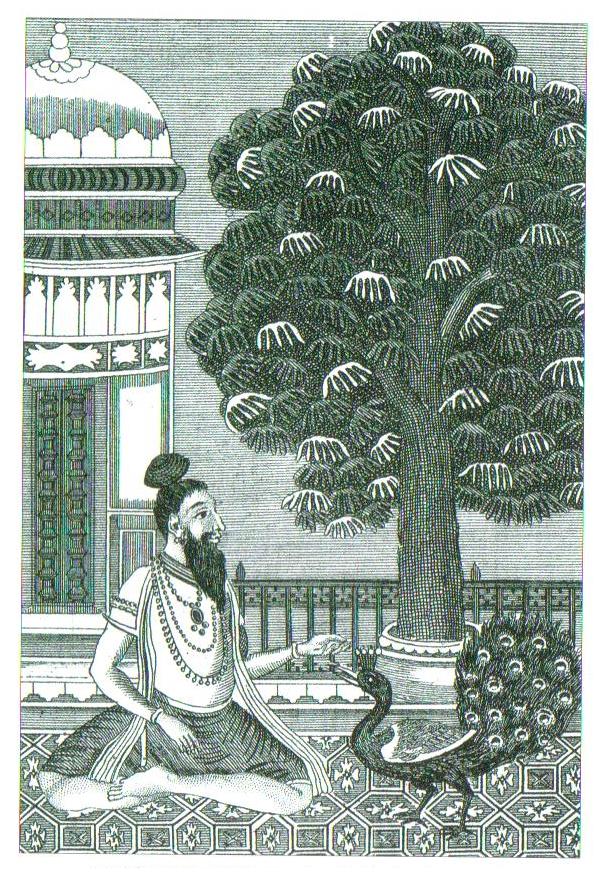
An
eighteenth century engraving of a Yogi and a peacock.
"Cases are known in which even Christian
missionaries, sent out to India to teach church doctrines to
clergymen or to preach Christianity among the Indians, became so
fascinated by the high and lofty teachings of the Upanishads
that they introduced the teaching of the Upanishads in the
Church and as a consequence were compelled to resign their
posts. "
(image
source: The Upanishads - Continuum - Ways
of Mysticism).
***
"Cases are known in which even Christian
missionaries, sent out to India to teach church doctrines to
clergymen or to preach Christianity among the Indians, became so
fascinated by the high and lofty teachings of the Upanishads
that they introduced the teaching of the
Upanishads
in the
Church and as a consequence were compelled to resign their
posts. "
"To the Hindus of all denominations there is nothing
higher and holier than the inspired sayings of the
Upanishads."
"The
forces of nature with their wonderful manifestations of
inexplicable marvels appeared to the early sages like great
beings endowed with life and personality. They were treated at
time as friendly, but again as hostile. Sometimes the mystery of
the natural phenomena seemed stupefying in its psychological
effect. The laws of nature were no obstacle to the free flight
of the imagination. When the Vedic sage saw the sun proceeding
in his upward and downward course through the sky he cried out
in his wonder:
"Undropped
beneath, not fastened firm, how comes it
That downward turned he falls not downward?
The guide of his ascending path, - who saw it"
The
sage is full of wonder that "the sparkling waters of all
rivers flow into one ocean without ever filling it."
Writing about
Hindu mysticism he observed:
"The
tiller of the soil and the grocer in the shop of India may be
uneducated and often wholly illiterate, but even they, while
tilling the ground, driving a bullock cart or resting after the
work of the day, will be singing songs full of mystical meaning,
and for the moment transporting themselves to regions beyond the
touch of material gains and comfort.
"The sky
and the earth are born of mine own eyes.
The hardness and softness, the cold and the heat are
the products of my own body;
The sweet smell and the bad are of my own nose."
"A traveler in the village of Bengal or on board the steamers
plying the rivers of the interior or rural Bengal, may often
hear a Hindu singing mystical, philosophical or mythical songs
of the love of Krishna and Radha while a large crowd of men is
assembled around the singer listening to him with great
reverence and feeling."
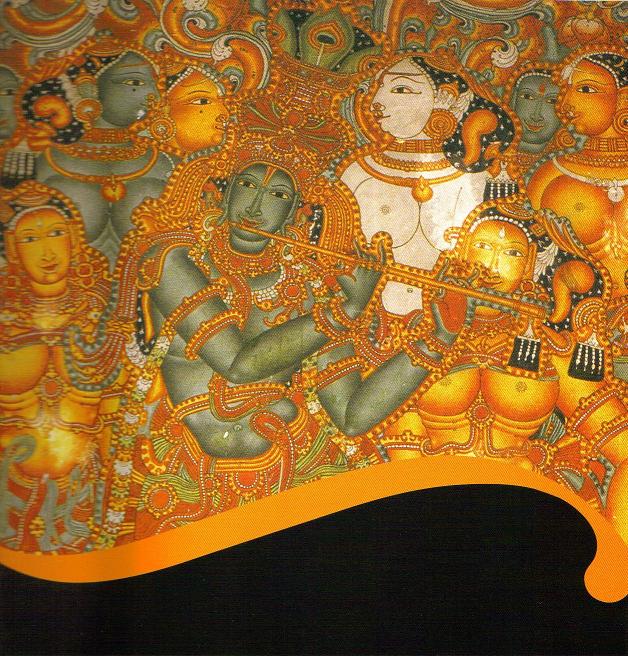
Lord
Krishna and the gopis,
"It
is only the educated or Anglicized Hindu who dazzled by the gay
colors of the West, sometimes turns a deaf ear to the old tune
of his country - the flute of Krishna calling from afar through
the rustling leaves of bamboos and the coconut groves of the
village homes - and, in the name of patriotism and progress,
installs a foreign god of money and luxury in the ancestral
throne of the god of the Indian heart - the god of
deliverance."
(image
from Mural
at Mattancherry Palace, Cochin, Kerala).
***
"The singer is probably describing the
world as a mirage or a mere phantom show of maya, or is
expressing the futility of his worldly life on account of his
having lost his friendship with his own self.
"My hope
of the world is all false,
What shall be my fate,
O kind, good lord?
I am not in love with him (self) with whom
I have come to live in this house (body)
O kind, good lord."
"So the
sublime teachings of philosophy and the other worldly
aspirations of mysticism, with their soothing, plaintive and
meditative tendencies, have watered the hearts of Bengal right
into the thatched cottages of this land. Wealth and comfort they
all appreciated as do people everywhere, but they all know that
money is not everything, and that peace of mind and the ultimate
good of man cannot be secured through it or any other worldly
thing. They are immersed in the world; but still the wisdom of
the ages and the teachings of the saints have not been in vain,
and at times they are drawn away from the world - their souls
unknowingly long for deliverance and find mystic delight in it.
"It
is only the educated or Anglicized Hindu who dazzled by the gay
colors of the West, sometimes turns a deaf ear to the old tune
of his country - the flute of Krishna calling from afar through
the rustling leaves of bamboos and the coconut groves of the
village homes - and, in the name of patriotism and progress,
installs a foreign god of money and luxury in the ancestral
throne of the god of the Indian heart - the god of
deliverance."
The thoughts
and aspirations of the ages, our myths, our religions, our
philosophies, our songs and poetry, have all interpreted and
formed a whole which cannot be expressed through a portrayal of
its elements. They represent a unique experience which I feel
with my countrymen, but which is incommunicable to anyone who is
unable imaginatively to bring himself into tune with that
spirit. The British in India have understood as much of the
country as is necessary for policing it, but no foreigner has
ever adequately understood our land."
(source: Hindu
Mysticism - By S N Dasgupta p. 1 - 30 and 141 -
168).
The lofty
heights reached by the ancient Hindus in the realm of philosophy and religion
was established and extensive literature exists on these topics.
(source:
History of Indian Philosophy – by
S N Dasgupta).
 430. Lowell
Jackson Thomas (1892 - 1981)
was an
American writer, broadcaster. A war correspondent in Europe and
the Middle East while in his 20s, Thomas helped make T.E.
Lawrence famous with his exclusive coverage and later with the
book With Lawrence in Arabia.
His radio nightly news was an American institution for nearly
two generations, and he appeared on television from its earliest
days. Out of his lifelong globetrotting came lectures,
travelogues, and more than 50 books of adventure and comment,
including Kabluk of
the Eskimo and The Seven
Wonders of the World. 430. Lowell
Jackson Thomas (1892 - 1981)
was an
American writer, broadcaster. A war correspondent in Europe and
the Middle East while in his 20s, Thomas helped make T.E.
Lawrence famous with his exclusive coverage and later with the
book With Lawrence in Arabia.
His radio nightly news was an American institution for nearly
two generations, and he appeared on television from its earliest
days. Out of his lifelong globetrotting came lectures,
travelogues, and more than 50 books of adventure and comment,
including Kabluk of
the Eskimo and The Seven
Wonders of the World.
He
observed in his book, India:
Land of the Black Pagoda:
“These
things ease the heart of man from sorrow,” says an Indian
sage, “water, green grass, and the beauty of a woman.”
“Hearts
ease from the burden of existence – that is the refrain that
runs through all the literature of Hinduism. This is true of
ancient times as of the present. When the forefathers of the
Pilgrim Fathers were still painting themselves a deep blue,
Indian culture was known in
Babylon
, and when the chariot of Boadicea was scything a lane through
the Roman ranks, the Romans of Rome were studying Aryan culture.
Literary
India
at the dawn of the Christian era was acting and reacting in a
wider world than the West was to know for fifteen centuries. But
release, absorption of the self in the cosmic whole, Nirvana,
has ever been the keynote. Hindu art-consciousness rests on the
sacramental view of life."
"The
Vedas,
believed by the Hindus to be the very Word of God, are among the
oldest books in the world, and reveal in beautiful simplicity
the life of a pastoral people, the Aryans, who migrated from
central
Asia
to the Indian plains. The Vedas and their glosses and
commentaries, forming the vast and as yet only partly translated
library of ancient Sanskrit writings, deal with every phase and
aspect of human emotion with a particularity and minuteness that
have hardly been equaled."
"Emile Coue’s
(1857 - 1926) formula of
getting better and better was long ago anticipated by the mantra
of the Ganges-side; Sigmund Freud
(1865 - 1939) is an
ignoramus beside the psychoanalysis of the Upanishads;
while as regards marital relations the Tantras makes Dr.
Marie Stopes (1880-
1958) of
England
seem a girl of seventeen. "
'The
later Sanskrit poems of men like Tulsi Das – the sweet singer
of the Ramayana – Kalidasa, and Bhartihari, who delivered
himself of the apothegm quoted above, are characterized by
copiousness, ingenuity, and a remarkable and very modern
interest in the function of thinking. Hardly any intellectual
process has been left unaccounted for.”
After
visiting Konark Sun Temple (Black Pagoda) he remarked:
“We
stand astonished. We saw a great, ornate pile of the general
form common to Hindu architecture, in which the pyramid seems to
be the general origin of design. It was a species of flattened
pyramid, with lines and proportions exquisite and perfect."
“As we approached, an extraordinary wealth of sculptured
decoration made itself manifest, for the sloping faces of the
Black Pagoda were carved, inch by inch over all their huge
expanse, with countless figures in deep and delicate relief. I
recalled the telling phrase of the renowned Bishop
Heber, that the Hindus
“build like Titans, and finish like jewelers.”

Konark
Sun Temple was known in English maritime charts as The Black
Pagoda.
Standing
on the edge of a wide beach on the Bay of Bengal, the
magnificent pile of weathered and oxidizing ferrugious sandstone
soars to a height of 100 feet, it used to form a landmark for
sailors far out at sea.
(image
source:
India: Land of the Black Pagoda - By
Lowell Thomas).
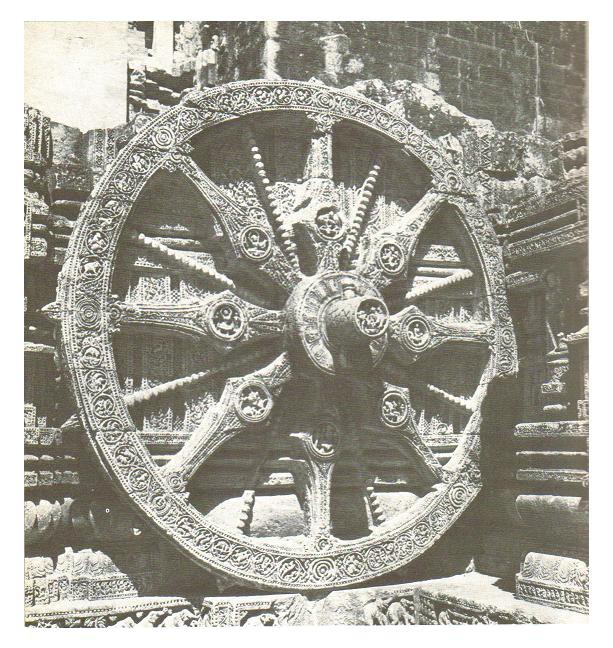
"Hindus build like Titans, and finish like jewelers.”
- wrote Bishop
Reginald Heber.
Konark,
Sun Temple was built during the reign of King Narasimhadeva I
(1238 - 64).
The temple was conceived as a gigantic stone
representation of the Sun God's Chariot. Twelve huge wheels are
carved into the plinth, and the building is preceded by seven
sculptured horses.
***
“We
sauntered among broken masses of sculptured stone, where
accessories of the giant structure have fallen. We walked with
eyes now lowered to some delicately carved fragment, now lifted
to the majestic proportions of the temple. We trod the ancient
floors of lofty inner rooms and sanctuaries. The sculptures were
exquisite, some of them in a green stone almost as lovely as
jade. The temple has the symbolical design of a chariot,
appropriately symbolizing the sun god. Great wheels are carved
in the lower exterior walls to represent the proper appendages
of a chariot. Dominant among the human figures is the splendid
presence of Vishnu in his solar guise. He is seen in perfectly
sculptured effigies of stone that are models of proportion and
of strength and delicacy.”
(source:
India: Land of the Black Pagoda - By
Lowell Thomas p. 238 – 240 and p. 326 – 329).
 431. Major
Francis Yeats-Brown (1886 - 1944) was the younger son
of an English diplomat. The Orient called to him and he became a
Bengal Lancer, although every turn of his mind was toward
scholarship, literature, and philosophy. His book The Lives of a
Bengal Lancer was perhaps the most extraordinary book ever
written about India by a westerner. 431. Major
Francis Yeats-Brown (1886 - 1944) was the younger son
of an English diplomat. The Orient called to him and he became a
Bengal Lancer, although every turn of his mind was toward
scholarship, literature, and philosophy. His book The Lives of a
Bengal Lancer was perhaps the most extraordinary book ever
written about India by a westerner.
Francis
Yeats-Brown liked Indians, so he was not unhappy to be sent to
an Indian regiment (17th Cavalry, Indian Army). But his
acquaintance with Indians and Indian culture educated him out of
humor with Western civilization. "Very humbly and
hopefully'' he went to Benares, holy city of the Hindus, there
to sit at the feet of Theosophist Annie Besant, How far
Yeats-Brown has progressed in the practice of Yoga is not clear.
But he tried the primary breathing exercises, says he attained
moments of impersonality. "Poised and relaxed and
completely in my body (not out of it, as the mystologues would
have it) I saw myself at times impersonally. The future lay at
my feet. I surveyed it as an interested traveler."
In India he plunged deeply
into the study of the Hinduism, Vedantism and
Yoga.
He was a
Bengal Lancer who became a yogi and wrote a book called Yoga
Explained.
(source: India:
Land of the Black Pagoda - By Lowell Thomas p. 10 -
12).
432.
Horace
Alexander (1899 - 1989) was an English Quaker,
diplomat, teacher
and writer, pacifist and ornithologist. He was the youngest of
four sons of Joseph Gundry Alexander (1848–1918). One of his
brothers was biologist Wilfred Backhouse
Alexander. He has observed that:
"Western scholars of our age, when they talk of
heritage of the ancient world, still commonly confine themselves
to the Mediterranean countries, with Mesopotamia and Arabia and Persia
possibly included. The ancient cultures of
China
and India
are omitted.

Horace
Alexander with Mahatma Gandhi.
“It is impossible to do justice to the profound
insights and philosophical majesty of the Bhagavad Gita as a
whole.”
“The wisdom of ancient India, which has sustained the lives of millions through the
centuries, is in fact highly relevant to the sickness of our
world order.”
***
"But the idea that the
Hindu tradition is dead,
an idea commonly accepted on the authority of Macaulay and
others in 19th century England, needs to be revised.
The India
of the Buddha, the Mahabharata, and especially of the Bhagavad
Gita, has come to a new birth. It is important, therefore, that
we examine both its roots and its new vitality."
“It is impossible to do justice to the profound
insights and philosophical majesty of the Bhagavad Gita as a
whole.”
“The Gita emphasizes that the activities of the
world must go on. The good man does the tasks to which he is
called and which appertain to his place in society. In all his
activities, he does things like others outwardly; but inwardly
he maintains a spirit of detachment. He does everything without
selfish motive, and maintains equilibrium of mind.
Self-knowledge is, in fact, the way from immaturity to maturity.
Many illiterate and poor Indian villagers are more mature as
persons than their western city counterparts, who have wealth,
knowledge of the kind that can be acquired through books,
technical skills and the other attributes of western
civilization. The
Gita shows man the way to live a complete and satisfying life."
“The wisdom of ancient India, which has sustained the lives of millions through the
centuries, is in fact highly relevant to the sickness of our
world order.”
“Many westerners are suspicious of “oriental
wisdom” because they think of it in terms of metaphysical
speculation, or in terms of gross superstition. The Gita is a
very remarkable book. Hinduism is perhaps the least dogmatic and
the most tolerant of religions.”
(source: Consider India: An essays in
values - By Horace Alexander p. 1 - 26).
 433.
Ed Viswanathan
(
) is
the author of the bestseller book, Am I
a Hindu?: The Hinduism Primer (1992) is a form of
dialog between a Hindu father and his American-born son. It
presents a great overview of Hinduism. 433.
Ed Viswanathan
(
) is
the author of the bestseller book, Am I
a Hindu?: The Hinduism Primer (1992) is a form of
dialog between a Hindu father and his American-born son. It
presents a great overview of Hinduism.
He has
written very astutely about the open mindedness of Hinduism and
one of its greatest traits, thus:
“Hinduism
has no problem facing any type of question. It does not have to
hide behind unpronounceable Sanskrit words or spiritual dogma.
Instead, it absorbs new ideas like a sponge. Believe it or not,
Hinduism recharges itself with modern thoughts. Technology,
psychology, parapsychology, modern astronomy, the new physics
and genetics all enrich Hinduism.” “Within Hinduism, you can
think and argue on any subject. It has no hierarchy, it has no
establishment and it has no governing body.”
Viswanathan
has
rightly pointed out that Hinduism readily and easily encompasses
a whole gamut of ideas and thoughts known to mankind:
“It has
highly spiritualistic Advaita and Raja Yoga on one side and
highly materialistic atheistic, hedonistic Charvaka philosophy,
which does not believe in God or the Vedas, on the other side.
On one side, idolatry is a part of Hinduism. The Jahala
Upanishad says, “Images are meant only as aids to meditation
for the ignorant.”
Hinduism
is not a religion that seeks to convert. In fact Hindus consider
it to be absurd to state that only one religion is the true
religion of the world.
Writing about this, he states:
“The
Hindu yogi will never try to convert a person from another
religion to Hinduism. Instead he will try to make a person’s
faith steadfast in his/her own religion. The Bhagavad Gita says,
“In whatever form a devotee seeks to worship Me with faith, I
make his faith steadfast in that form alone.” He further
explains about sin in Hinduism: “Hinduism very scientifically
deals with sin, explaining the law of karma, or cause and
effect. All the parables in mythology explain how to deal with
sins in a very positive manner. When a child puts his hand in
fire, he gets burned. His action here is due to his ignorance of
the power of fire. The child did not commit a sin, but due to
his ignorance of the truth that fire burns, he did a bad Karma
and he had the result of getting burned. That is the way the
idea of sin is explained in Hinduism. Christianity has stressed
sin and fear of God and hell. Hinduism stands against the
doctrine of sin.”
(source:
Am I a Hindu? The Hinduism Primer - By Ed
Viswanathan
Halo Books
San Francisco
p. 1-5 and 287).
 434.
Dr. William Ralph Inge
(1860 - 1954) Anglican Platonist author in his Christian
Mysticism refers to the mystic strains in the early
thinkers. 434.
Dr. William Ralph Inge
(1860 - 1954) Anglican Platonist author in his Christian
Mysticism refers to the mystic strains in the early
thinkers.
Inge, however, agrees with Heiler in looking upon the negative
descriptions of the deity and the world-denying character of
ethics as Indian in origin. He says:
“The doctrine that God can be
described only by negatives is neither Christian nor Greek, but
belongs to the old religion of India.”
"To give a negative
account of God is to affirm His immensity of being."
(source: Eastern
Religions & Western Thought - By. Dr. S. Radhakrishnan
p. 293).
435. Richard
Schiffman ( ) is nationally known
as an on-air journalist whose features regularly appear on the
National Public Radio shows: Morning
Edition, All Things Considered, and Living of Earth.
He has studied in
India
for over four years and is the author of Sri
Ramakrisnhna - Prophet for the New Age (1989).
Schiffman lived in
India
for a number of years and studied Hindu spirituality under
several spiritual Masters, including the Jillellamudi Mother,
Bhagavan Sri Sathya Sai Baba and Mata Amritananadamayi. He is
the author of Mother of All, a biography of the Jillellamudi
Mother, and former editor of the Matrusi Journal.
He has observed about the
Upanishads thus:
“These sparse treatises of
great beauty, intensity, and revelatory power are set for the
most part in the form of dialogues of spiritual guidance between
youthful seekers and their enlightened masters, the immortal
rishis. The approaches pioneered by the rishis remain to this
day the mainstays of Hindu mystical practices.”

Sleeping
Narayana from Budha Nilakantha, Nepal, circa 8th century. stone
more than life size.
Lord Vishnu
reclining on the coils of a cosmic serpent on the infinite ocean
from which the world emerges. The Lord is shown lying down on a
thousand-headed snake named Shesha or Ananta Nag - Timeless or
Ageless snake.
“This
primal insight into the dreamlike nature of the world of
appearances has an oddly contemporary resonance given the
direction of modern scientific thought. Long before
post-Newtonian physics “discovered” that matter is
essentially energy in drag – E =MC2 – the sages had already
intuited that the physical universe is an emanation of the
omnipotent Force, which they call Shakti.
photo
courtesy: Dr. Deepak Shimkhada.
(image
source: A
Tribute to Hinduism: Thoughts and Wisdom spanning continents and
time about India and her culture - By Sushama Londhe).
***
“Living
far from the concerns of the larger society, these sages
nonetheless initiated a revolution in thought and spiritual
practice which would spread throughout Asia and beyond, setting
the basic agenda for the development of over two millennia of
Eastern civilization – and just now sparking some interesting
fireworks along the cutting edge of our own exploration which
has continued until the present day. And they charted in
breathless and enigmatic words – the only words possible for
describing such a mystery! – the rough outlines of a realm as
wide as the cosmos and equally as wondrous. For had not the sage
of the Chandogya Upanishad declared: “The little space within
the heart is as great as this vast universe.
The heavens and the earth are there, and the sun and the moon,
and the stars; fire and lightning and winds are there; and all
that now is and all that is not: for the whole universe is in
Him and He dwells within our hearts.” “With words such as
these, the rishis were the first to proclaim the virtually
unlimited potential of consciousness, not as an abstract
theoretical possibility, but as an experiential reality.”
“The Upanishads are the
living expression of that understanding.”
Reflecting on post-Newtonian
physics, he has noted that:
“This
primal insight into the dreamlike nature of the world of
appearances has an oddly contemporary resonance given the
direction of modern scientific thought. Long before
post-Newtonian physics “discovered” that matter is
essentially energy in drag – E =MC2 – the sages had already
intuited that the physical universe is an emanation of the
omnipotent Force, which they call Shakti. “By Primal Energy,
all that exist is born; by Primal Energy all that exists is
sustained; and into Primal Energy all that exists returns in the
end.” Creation, according to this view, is neither static, nor
at base even material, but a dynamism of ceaseless
transformation, the ecstatic dance of the Divine Mother Kali.
The astrophysicist, the molecular biologist, the subatomic
physicist could only agree.”(source:
Living
Wisdom: Vedanta in the West - Edited By Pravrajika
Vrajaprana Vedanta
Press. Hollywood,
CA
p. 60 – 70). Refer
to The
Vedanta Kesari
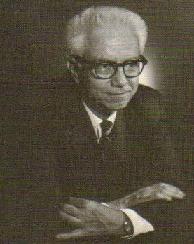 436. John
Moffitt ( ) a graduate of Princeton and the
Curtis Institute of Music, was a monastic member of the order of
Ramakrishna for 25 years and then became a Catholic. In his
book, Journey to Gorakhpur he gently leads the Westerner to
shed his cultural imperialism in an encounter with the ongoing
vitality of Indian tradition. He said that Christians must guard
against a premature assumption that God intended everyone in the
East to become a professing Christian. 436. John
Moffitt ( ) a graduate of Princeton and the
Curtis Institute of Music, was a monastic member of the order of
Ramakrishna for 25 years and then became a Catholic. In his
book, Journey to Gorakhpur he gently leads the Westerner to
shed his cultural imperialism in an encounter with the ongoing
vitality of Indian tradition. He said that Christians must guard
against a premature assumption that God intended everyone in the
East to become a professing Christian.
"The
majority of the people in the West have largely misunderstood
both (Hinduism and Buddhism) religions. Up till now these
ancient faiths have been devoutly misrepresented by most
scholars who are professing Christians."
"Hinduism's
doctrine of the "divinity" of the soul, the non
duality of the Godhead, the unity of existence, and the harmony
of religions were strongly appealing and
he joined the Ramakrishna Order of India, working at the
Ramakrishna-Vivekananda Center of New York under the direction
of Swami Nikhilananda."
"In
India, after all, religion is like the air you breathe, and
almost every Hindu's given name had a religious association. But
is is not just a matter of conventions. Even villagers who
practice what look to Westerners, like grossly superstitious
forms of worship are not unfamiliar with many of the subtleties
of what we in the West would call scholastic
philosophy."
"The
Upanishads announce the advent of a new consciousness of the
nature of ultimate reality. Even among the earlier hymns of the
Vedas we find one or two that contain speculations about the
first cause of the universe. But with the Upanishads we have a
new and liberating revelation. The Upanishads record the efforts
of the later Vedic sages to communicate to qualified pupils what
they had found as a result of their quest for the True Self of
man and the Divine Ground of the Universe. These treatises,
though they still reflect some of the earlier beliefs, offer a
profound insight into the nature of ultimate reality and of the
soul. Traditional Christian thought would no doubt brand the
Upanishadic record as heretical. Yet,
from the point of view of intuitive wisdom, it is far more
explicit about the soul's relationship to God than any of the
books of the New Testament."
The
use of the phrase "the truth of truth" has a peculiar
fitness in the Hindu context. In India men have from time
immemorial emphasized the centrality of truth. The Rig-Veda, the
earliest of Indian scriptures, declares: "It
is truth that bears up this earth."

Temple
at Shambhunath
"The Self is never
born, nor does it ever die, nor, having once been, does it again
cease to be. Unborn, eternal, permanent, and primeval, it is not
slain when the body is slain." "Weapons cut it not,
fire burns it not, water wets it not, the wind does not wither
it."
These few
quotations from the Bhagavad Gita, like those from the
Upanishads, offer only an infinitesimal hint of the rich variety
of experience in the form of intuitive wisdom to be found in the
Hindu canonical scriptures. They show the kind of thinking and
experience that preoccupied the later Vedic seers.
(image
source: Indika:
The Country and the people of India and Ceylon - By
Rev. John F Hurst).
***
The Taittiriya
Upanishad, a source book for Shankara's
Vedanta philosophy, says, "The Satya (the Truth)
became all this: whatever there is." And this veneration of
truth has continued into modern times. It is well known that Mahatma
Gandhi, though for many years in the habit of saying,
"God is Truth." Perhaps without knowing it, he had
gone back to the Vedas. The Hindu scriptures abound with
reference to acts of truth. When the earth opened at Queen
Sita's bidding, in the Ramayana
story, and when she passed through the flames unscathed, what
happened bore witness to her perfection in truth.
The
Bhagavad Gita not only illuminates but carries
forward the teachings of the Upanishads in a grand synthesis
whose potentialities were only fully realized in India over two
millenniums later. In his instruction, Lord Krishna defines not
only what Arjuna's duty is as dictated by his position in
society, but also the basis of belief for those who by nature
emphasize the voice of intuitive wisdom. Followers of this voice
speak of the Bhagavad Gita as a dialogue between the Supreme
Self and the individual self. "The unreal never is,"
Krishna says. "The Real never ceases to be...That by which
all this is pervaded know to be imperishable...The Self is never
born, nor does it ever die, nor, having once been, does it again
cease to be. Unborn, eternal, permanent, and primeval, it is not
slain when the body is slain." "Weapons cut it not,
fire burns it not, water wets it not, the wind does not wither
it. Here we have the Upanishadic doctrine of Atman, spelled out
in slightly greater detail. These few
quotations from the Bhagavad Gita, like those from the
Upanishads, offer only an infinitesimal hint of the rich variety
of experience in the form of intuitive wisdom to be found in the
Hindu canonical scriptures. They show the kind of thinking and
experience that preoccupied the later Vedic seers. Those who
followed them in the post-Vedic age, by weaving their findings
into the stories of legendary heroes, made these available to
average man. They also provided future generations with their
first detailed, though perhaps partly idealized, view of
everyday life in ancient India."
The
Bhagavad Gita offers a highly refined and well-balanced
exposition of love of God.
(source: Journey
to Gorakhpur: An Encounter with Christ beyond Christianity -
By John Moffitt p. 1 - 89).
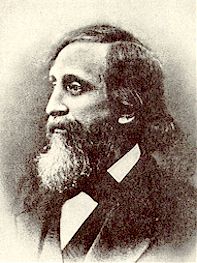 437.
Samuel Johnson
(1822- 1882)
went to private schools, Harvard, and then
Harvard
Divinity
School
from which he graduated in 1846. Among his class mates were Octavius
Brooks B Frothingham and his lifelong friend Samuel
Longfellow, brother of Henry Wadsworth
Longfellow. 437.
Samuel Johnson
(1822- 1882)
went to private schools, Harvard, and then
Harvard
Divinity
School
from which he graduated in 1846. Among his class mates were Octavius
Brooks B Frothingham and his lifelong friend Samuel
Longfellow, brother of Henry Wadsworth
Longfellow.
Johnson
was a minor Transcendentalist whose faith was centered in
naturalism, and he rejected much of Christian tradition as
revelatory, and held little faith in established institutions
always refusing to join any organized groups. His later years
were devoted to study and writing. He often looked outside of
Christianity for his inspiration. In his hymn. “Life of
Ages,” he writes, “never was to chosen race that unstinted
tide confined.” His work on eastern religions was especially
important. He published three volumes of his Oriental
Religions.
These were
India
(1872),
China
(1877) and
Persia
(1885).
Johnson
shared characteristics with Emerson’s Transcendentalism; like
Emerson, Thoreau, he was capable of seeing daily life in terms
of Hinduism.
He
criticizes the West and contemporary Western society and wrote
in his essay “Fulfillment of Functions” begins with words
“Doing one’s own duty badly is better than doing another’s
well - The Hindu concepts of Svadharma,
which can be translated as “fulfillment of functions.”
The
terms of disease and corruption clearly show Johnson’s
dissatisfaction with current
America
, and at the end of the essay he exhorts:
“Let
us educate for this principle (svadharma). Let us flood these
torch-light politics, this pitchy trade, these pyrotechnic
manners, with its simple, open day. Let us substitute it for the
herded dependence and noisy Baal-worship that is called
religion, and vindicate the name that is broader and more
beautiful than Christianity itself. For this is the prophecy in
the struggling heart of humanity today.”
Here
Christianity is implicitly compared with Baal worship and is
being prophetically replaced by the “svadharma” derived from
Hinduism.
Johnson
restates the Hindu doctrine of
svadharma that underlies the caste system; every man
should fulfill the function to which he was born. Svadharma was
at odds with American notion of personal liberty, and Johnson
wrote:
“The
American takes his oath to public opinion in the name of
freedom.” But “there is no tyranny, after all, more terrible
than the public opinion which forces all men into availability
for all uses.” “Above all, must individual culture be
guarded from the tyranny of mere mass-power.”

Rameswaran
temple.
He has termed the
Hindu mind the
“brain” of
Asia
, being “subtle, introversive…cerebral,” made for
mediating between thought and work.
***
Johnson’s
prose is as vigorous and as inspiring as anything Emerson wrote.
He observed:
“The
old Hindu philosophy called everything below God
Maya or
Illusion. There is a practical truth veiled here we all must
learn. You have seen a little picture of what seems to be a
death’s head; but which, as you approach it, turns into a
pleasant room, and the eyeless sockets become two happy children
at play. It is a petty trick of art; but the sublime craft of
nature is imagined in it. We cannot comprehend what we call
evil, in any form, until we remember the laws of illusion.”
He
asserted that “it was time the older religions were studied in
the light of their own intrinsic values. They are at once
spontaneities of desire and faith,” and, he affirms, it is
time that Westerners cease following the belief that
“Christianity will tolerate no rival,” as one missionary
write put it, cease to use the Orient, to prove “the
superiority of Christendom.”
This universalism appears throughout his work. When
speaking of the Himalayas as the Edenic center of the world,
Johnson calls them
Mount
Merus, the Bible of all Asia, source of all the world’s religion,
just as the “great rivers of
Asia
descend on every side.”
He has termed the Hindu mind the
“brain” of
Asia
, being “subtle, introversive…cerebral,” made for
mediating between thought and work.
About
The Mahabharata and Ramayana
he notes that they “glow with a luxuriance of imagery which
contrasts with the Iliad or AEneid as the stupendous vegetation
of
India
differs from that of
Italy
or
Greece
. All that this colossal people have dreamed or done in
philosophy, mythology, ethics, in imaginative or didactic
thought, is here transmuted into song."
He was a man with a scholarly bent of mind and for a single
statement about the antiquity of Hindu
devotionalism he cited pages from Muller, Whitney,
Duncker, Koeppen, Colebrooke and Lassen. He was able to provide
an extensive and clear and accurate
portrayal of Hindu gods and practices. His
discussions of Indra, Varuna, Vishnu and Agni and their
counterparts in the Greek and Hebrew religions; his discussions
of the Laws of Manu, the caste system, Vedanta, Sankya,
transmigration, and Buddhism spanning in total over eight
hundred pages demonstrate Johnson's interest and scope. He wrote
that Buddhism remained within the old Hindu circle.
(source:
American
Transcendentalism and Asian religions - By Arthur Versluis
p 100 - 262).
 438. Willy
Haas
(1891- 1973) German writer and contemporary of Heinrich Zimmer
and Herrmann Goetz once stated that: 438. Willy
Haas
(1891- 1973) German writer and contemporary of Heinrich Zimmer
and Herrmann Goetz once stated that:
“At
its culminating point, Indian art does not attempt to represent
eternity through the fleeing moment, duration through change or
god through nature, on the contrary: it makes change appear
through permanence, the variable through identity."
“As an
example he quotes the Trimurti at Elephanta, where the
triple-faced head of Shiva shows the three aspects of Shiva as
Brahma (the creator), as Vishnu (the preserver), and as Rudra
(the destroyer), thereby achieving the ever sought after
identity of form and content.
This old quest for the perfect
harmony of form and content was forged into a grand image by
Rabindranath Tagore in our times “I plunge into the very
depths of the ocean of forms, hoping to find the perfect and
formless pearl.”
(source:
Treasures of Indian Art: Germany's
Tribute to India's Cultural Heritage - National Museum
p. foreword by Dr. Georg Lechner, Director Goethe – Institut
Muechen).
 439.
Martin Gray ( ) is an
anthropologist and photographer specializing in the study of
sacred sites and pilgrimage traditions around the world. His father
was in the
US
diplomatic service and was privileged to travel widely around
the world. When he was twelve years old his family moved to
India
for four years. During this period he went on frequent journeys,
both alone and in the company of wandering holy men, to the
temples, mosques and sacred caves of
India
,
Nepal
and
Kashmir
. Reading widely in the fields of Buddhism and Hinduism, he
became intrigued with the beauty and mystery of the sacred
places of India.
During
the past eighteen years, Martin has visited and photographed
over 1000 sacred sites in seventy countries. His efforts
culminate with a beautiful website called Places of Peace and
Power, which can be found at: www.sacredsites.com. 439.
Martin Gray ( ) is an
anthropologist and photographer specializing in the study of
sacred sites and pilgrimage traditions around the world. His father
was in the
US
diplomatic service and was privileged to travel widely around
the world. When he was twelve years old his family moved to
India
for four years. During this period he went on frequent journeys,
both alone and in the company of wandering holy men, to the
temples, mosques and sacred caves of
India
,
Nepal
and
Kashmir
. Reading widely in the fields of Buddhism and Hinduism, he
became intrigued with the beauty and mystery of the sacred
places of India.
During
the past eighteen years, Martin has visited and photographed
over 1000 sacred sites in seventy countries. His efforts
culminate with a beautiful website called Places of Peace and
Power, which can be found at: www.sacredsites.com.
He
has remarked that:
"In
India
we find the oldest continually operating pilgrimage tradition in
the entire world. The practice of pilgrimage in
India
is so deeply embedded in the cultural psyche and the number of
pilgrimage sites is so large that the entire subcontinent may
actually be regarded as one grand and continuous sacred
space."

Mount Kailash
"In
India
we find the oldest continually operating pilgrimage tradition in
the entire world. The practice of pilgrimage in India
is so deeply embedded in the cultural psyche and the number of
pilgrimage sites is so large that the entire subcontinent may
actually be regarded as one grand and continuous sacred
space."
Refer
to chapter on Nature
Worship.
***
"In
discussing pilgrimage places in the Hindu tradition, it is
important to say a few words about the number and diversity of
deities in Hinduism and about the iconic and aniconic forms in
which those deities are found. The personification of the
mysterious forces of the universe into the anthropomorphic
deities of the Hindu tradition involves both a convergence into
certain supreme deities (the main three deities today are the
gods Shiva and Vishnu and the goddess Shakti) and a splintering
into a myriad of lesser deities. Certain writers call this
polytheism, but the term is inaccurate in this case."
Hindu
seriously believes in the multiplicity of gods but rather is
aware that each of the many gods and goddesses are merely
aspects of the One God (who is also the god of all other
religions). The majority of Hindus ally their beliefs with one
or the other of the three cults, worshipping Shiva, Vishnu, or
Shakti as the highest principle. In doing so they do not deny
the existence of the other two deities but regard them as
complementary, though minor, expressions of the same divine
power. Hinduism is thus, in its essence, monotheistic; a Hindu's
worship of a particular personal deity is always done with the
awareness that all deities are simply representations of one
unconditioned, transcendental, supreme existence, known as
Brahman. Each of the greater and lesser deities is understood as
a sort of window or lens through which the whole of reality may
be glimpsed.
The primary intention of a pilgrim's visit to a holy site is to
receive the darshan of the deity resident in the temple's inner
sanctum or open-air shrine. The word darshan, difficult to
translate into English, generally means the pilgrim's having a
sight and/or experience of the deity. Hindus believe that the
deity is actually manifest in the image, statue, or icon of the
temple. To receive the darshan of the deity is to have a
spiritual communion with it. The image of the deity may either
be an iconic, or representational, image that bears some
resemblance to its mythic subject; or an aniconic form that
merely symbolizes the deity.
In a
large number of celebrated shrines in India
no beautiful statues of the gods and goddesses are found, but
only aniconic blocks of stone or stumps of wood. This tradition
of aniconic images derives from the rural folk religions of
ancient
India
and bears witness to the great antiquity of the sanctity of
certain places. The shrine in its initial phase may have been
only a crude little hut covering a stone that both represented
and contained some spirit of the natural world. As millennia
passed and the small rural village grew slowly into a larger and
larger town, both the myths concerning the stone and the shrine
surrounding that stone were richly elaborated. It is therefore
important when studying or visiting the monumental pilgrimage
shrines of India
to rememberthat they had their architectural genesis in the
simple nature sanctuaries of the pre-Aryan rural folk.

Lord Ganesha
Kangra c.1815 Bharat Kala Bhavan.
Hinduism is thus, in its essence, monotheistic; a Hindu's
worship of a particular personal deity is always done with the
awareness that all deities are simply representations of one
unconditioned, transcendental, supreme existence, known as
Brahman. Each of the greater and lesser deities is understood as
a sort of window or lens through which the whole of reality may
be glimpsed.
***
The myths and legends of these sacred places have their roots in
the ancient peoples' felt experience of the characteristics or
qualities of the natural place. The various mythological
personality characteristics of the deities in pilgrimage shrines
may therefore be interpreted as metaphors for the way in which
the spirit of the place has affected human beings. This spirit
of place is not just a fanciful story, it is an actuality, an
energy, a presence that touches human beings and affects them
profoundly. Why are certain places said to be the dwelling place
of a feminine deity and others the dwelling place of a masculine
deity? Is it not perhaps because some ancient rural people,
deeply in touch with the earth as a living entity, sensed either
a feminine or masculine presence at a place and spoke about it
in anthropomorphic terms? These terms were then given
representational form by the artistic rendering of a statue or
image.
Looking deeper into this matter, let us then ask why there are
not simply male and female deities but, more precisely, why
there are different kinds of male and female deities?
Conventional explanations refer to such things as the fanciful
human imagination, the rich and varied proto-religious inputs
into formative Hinduism, and prehistoric deification of
charismatic human figures into legendary archetypes. While all
these things did occur, they are not the only explanations. The
central premise of my theory is that the different personality
characteristics of the deities derive from the various
characteristics of the Earth spirit as it manifests at different
geographical locations. To understand the quality or character
or power of a place, we need only study the nature of the deity
enshrined there. Encoded in the deity's mythological form is a
clear message telling us how the sacred site will affect us.
(source: Sacred
Places: Sacred Sites, places and temples in
India - By Martin Gray).
 440.
Mani
Bhaumik ( ? )
is a Bengali elected fellow of the
American Physical Society as well as the Institute
of
Electrical
and Electronics Engineers and is the author of the bestseller
Code Name God. He is the co-inventor of the laser technology
that made LASIK surgery possible. 440.
Mani
Bhaumik ( ? )
is a Bengali elected fellow of the
American Physical Society as well as the Institute
of
Electrical
and Electronics Engineers and is the author of the bestseller
Code Name God. He is the co-inventor of the laser technology
that made LASIK surgery possible.
Bhaumik says ancient
Indian philosophy, put into action by Gandhi, has its
counterpart in modern science. He says both try to explain the
cosmos and improve the world.
“The
ancient Vedantic concepts that we all cut our spiritual teeth on
are a part of the grand reconciliation now going on between
science and religion. We find these concepts embodied in the
extensive literature starting with the four Vedas and their
subsequent elaborations in the Upanishads. The recurring theme
of these perceptions is that, underlying all physical reality,
there is one abstract entity, Brahman, with the quality of
consciousness.”
“Having
created the universe, Brahman remains present everywhere today,
administering basic aspects of everything in our cosmos. Recent
scientific discoveries seem to validate the concept of Brahman.
Physicists and cosmologists are close to proving that there is
one source behind the physical universe, and they call this
source the unified field. In a profound sense, Brahman, the
Vedantic concept and the unified field of physics appear to be
synonymous. All the physical objects and phenomena around us are
not illusory or maya, but are quite real. However, what we see
is only the tip of the iceberg. Underneath it is the interplay
of an abstract substance called energy, which in turn is
controlled by something even more abstract: The fields that
underlie all physical reality.”
“The
compilers of the Vedas were the first monotheists, Bhaumik
points out.
“In the West, when we think of monotheism, we
think of a being. But the Vedists did not think of a being, they
thought of an abstract entity that they called Brahma, which
some people deify and think of as a being. But God is the source
of everything, not a being but a transcendent power.”
(source:
Physics
& Vedanta: So much in common – By Mani Bhaumik –
bikramyoga.com and Code Name
Success – India, Life and Style).
Top of Page
Show
in alphabetical order


Page < 1 2 3 4 5 6 7 8 9 10 11 12 13 14 15 16 17 18 19 20 21 22 23 24 >
|